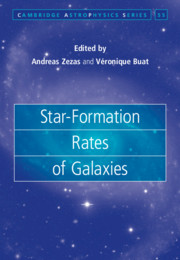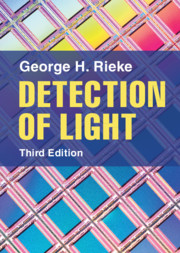Refine listing
Actions for selected content:
16950 results
8 - Bolometers
-
- Book:
- Detection of Light
- Published online:
- 30 April 2021
- Print publication:
- 13 May 2021, pp 245-278
-
- Chapter
- Export citation
Appendix B - Answers to Selected Problems
-
- Book:
- Detection of Light
- Published online:
- 30 April 2021
- Print publication:
- 13 May 2021, pp 347-349
-
- Chapter
- Export citation
Contents
-
- Book:
- Detection of Light
- Published online:
- 30 April 2021
- Print publication:
- 13 May 2021, pp v-viii
-
- Chapter
- Export citation
References
-
- Book:
- Detection of Light
- Published online:
- 30 April 2021
- Print publication:
- 13 May 2021, pp 350-365
-
- Chapter
- Export citation
Preface
-
- Book:
- Detection of Light
- Published online:
- 30 April 2021
- Print publication:
- 13 May 2021, pp ix-x
-
- Chapter
- Export citation
Index
-
- Book:
- Detection of Light
- Published online:
- 30 April 2021
- Print publication:
- 13 May 2021, pp 366-370
-
- Chapter
- Export citation
4 - Infrared (and Optical) Photodetectors
-
- Book:
- Detection of Light
- Published online:
- 30 April 2021
- Print publication:
- 13 May 2021, pp 99-133
-
- Chapter
- Export citation
7 - Superconducting Detectors
-
- Book:
- Detection of Light
- Published online:
- 30 April 2021
- Print publication:
- 13 May 2021, pp 215-244
-
- Chapter
- Export citation
6 - Other Photodetectors
-
- Book:
- Detection of Light
- Published online:
- 30 April 2021
- Print publication:
- 13 May 2021, pp 174-214
-
- Chapter
- Export citation
Frontmatter
-
- Book:
- Detection of Light
- Published online:
- 30 April 2021
- Print publication:
- 13 May 2021, pp i-iv
-
- Chapter
- Export citation
5 - Charge Coupled Devices
-
- Book:
- Detection of Light
- Published online:
- 30 April 2021
- Print publication:
- 13 May 2021, pp 134-173
-
- Chapter
- Export citation
Appendix A - Useful Constants and Conversions
-
- Book:
- Detection of Light
- Published online:
- 30 April 2021
- Print publication:
- 13 May 2021, pp 346-346
-
- Chapter
- Export citation

Star-Formation Rates of Galaxies
-
- Published online:
- 11 May 2021
- Print publication:
- 29 April 2021

Detection of Light
-
- Published online:
- 30 April 2021
- Print publication:
- 13 May 2021
11 - Black Holes
- from Part III - Applications
-
- Book:
- General Relativity: The Essentials
- Published online:
- 19 August 2021
- Print publication:
- 29 April 2021, pp 123-139
-
- Chapter
- Export citation
Part II - SFR Measurements
-
- Book:
- Star-Formation Rates of Galaxies
- Published online:
- 11 May 2021
- Print publication:
- 29 April 2021, pp 113-114
-
- Chapter
- Export citation
Part I - Background
-
- Book:
- Star-Formation Rates of Galaxies
- Published online:
- 11 May 2021
- Print publication:
- 29 April 2021, pp 1-2
-
- Chapter
- Export citation
8 - Gravitational Waves
- from Part III - Applications
-
- Book:
- General Relativity: The Essentials
- Published online:
- 19 August 2021
- Print publication:
- 29 April 2021, pp 83-94
-
- Chapter
- Export citation
9 - Modelling the Spectral Energy Distribution of Star-Forming Galaxies with Radiative Transfer Methods
- from Part II - SFR Measurements
-
-
- Book:
- Star-Formation Rates of Galaxies
- Published online:
- 11 May 2021
- Print publication:
- 29 April 2021, pp 204-224
-
- Chapter
- Export citation
Preface
-
- Book:
- General Relativity: The Essentials
- Published online:
- 19 August 2021
- Print publication:
- 29 April 2021, pp ix-x
-
- Chapter
- Export citation
